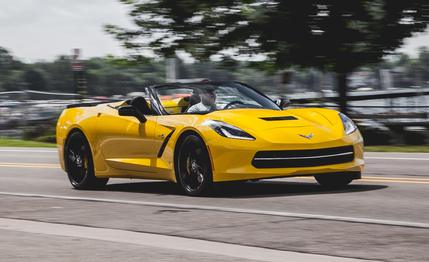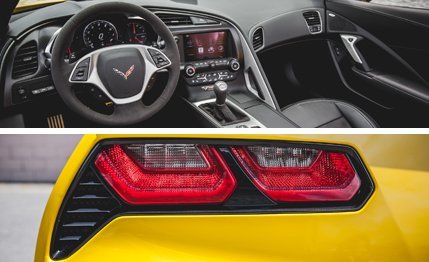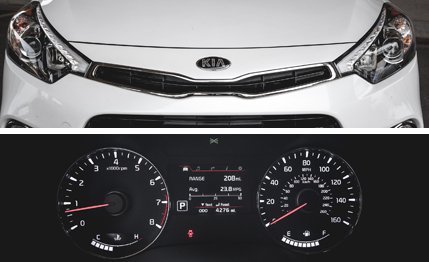 Instrumented Test
Instrumented Test
Pop open the electronically actuated door of any new Corvette Stingray and the odor of plastic resin greets you. Smelling like a martini made with counterfeit Chinese vodka, the C7 coupe can’t go al fresco quickly enough—via its standard removable roof panel—when it’s been sitting in the sun. Maybe GM needs to install a perfume dispenser like the one in the Mercedes-Benz S-class. If it does, can we get a bacon fragrance?
Or you can just opt for the convertible. It takes only 21 seconds to drop the top, and you can go ahead and pull away from the curb once the process has started; the roof works as long as you keep your speed below 30 mph, which is more than fast enough for extricating the car from wherever it’s parked.
From behind the wheel, you would never know the coupe and the convertible are different cars as long as you avoid looking in the rearview mirror. Stow the coupe’s targa top in the cargo area and you’ll even get the same sunburn. But the ease and speed of operating the one-button convertible top stand in stark contrast to the triple latches of the coupe’s removable panel. You will enjoy open-air motoring more in the convertible because you will be more likely to motor in the open air.

Some of the usual downsides apply. The convertible has a small trunk, it is less suited for track days, and it has an awkward profile with the top up. And yes, as with any soft top, there are security concerns. But you needn’t be concerned with performance numbers. When it launched the C7 Corvette, Chevy promised that the convertible would deliver identical performance to the coupe. After our first drive, we had no reason to doubt this assertion, and our testing gear now confirms it. A Z51 package–equipped convertible turned in a performance at the test track that very nearly carbon-copied that of our similarly equipped long-term Stingray coupe.
Both seven-speed manual-equipped cars ran from 0 to 60 mph in 3.9 seconds. Through the quarter-mile, the convertible was a tenth behind at 12.3 seconds and hit the traps at 117 mph, a single mile per hour slower than the coupe. Braking from 70 mph took 138 feet in the convertible, just one foot longer. Both cars exceeded 1.00 g on the skidpad. Top speed favors the more aerodynamic coupe by 3 mph, but a drag-limited 178 mph in the convertible is certainly not slow. In fact, it’s 7-mph higher than a Jaguar F-type can achieve and 2-mph more than a Porsche Boxster S. So, yes, the C7 Stingray convertible is much more than simply the Corvette model least likely to lead to an inhalants addiction.
Get it out on the street, dial it into Sport mode, and hear the rumble start to go scary and dark. If you have the $1195 performance exhaust of our test car, it will get much louder, much sooner. (And if you’re behind the wheel of a 2015-model-year Z51 Vette, you do have the exhaust; Chevy has rolled the formerly standalone option into the expansive Z51 package.) Punch it—as you should—but hold on when the nose pops up just a little and the rear end squirms. That’s 460 horsepower and 465 lb-ft of torque from the 6.2-liter V-8 making you feel like some tainted booze is reversing its path through your system. And the sound, oh, it is angry. (Note: The $62,995 base price in the specs is for a 2014 car with the Z51 kit and nothing else; the non-Z51 convertible starts at $58,995.)

With this car, Chevy has addressed all the shortcomings of the C5/C6 era. There’s still a bit of Millennium Falcon to the Stingray, which is not quite as polished as Porsche’s Tie Fighters. The Corvette shakes at idle, and all manner of rumbles and twitches are communicated from the chassis to the driver—and not just through the excellent steering. The Corvette moves, it feels alive underneath you, more animal than robot.
Paradoxically, comfort seems less of a priority than in years past, but the improvements to the interior and seats made for this generation have resulted in a Corvette that’s actually more comfortable than ever. The shifter still requires some strong-arming, and its natural resting point between third and fourth gear means that you must be doubly sure you’ve selected first, although the car will launch in third without stalling. But the control relationships are outstanding, and if you can’t find a happy place in this cockpit, you might need to drive something other than a sports car.